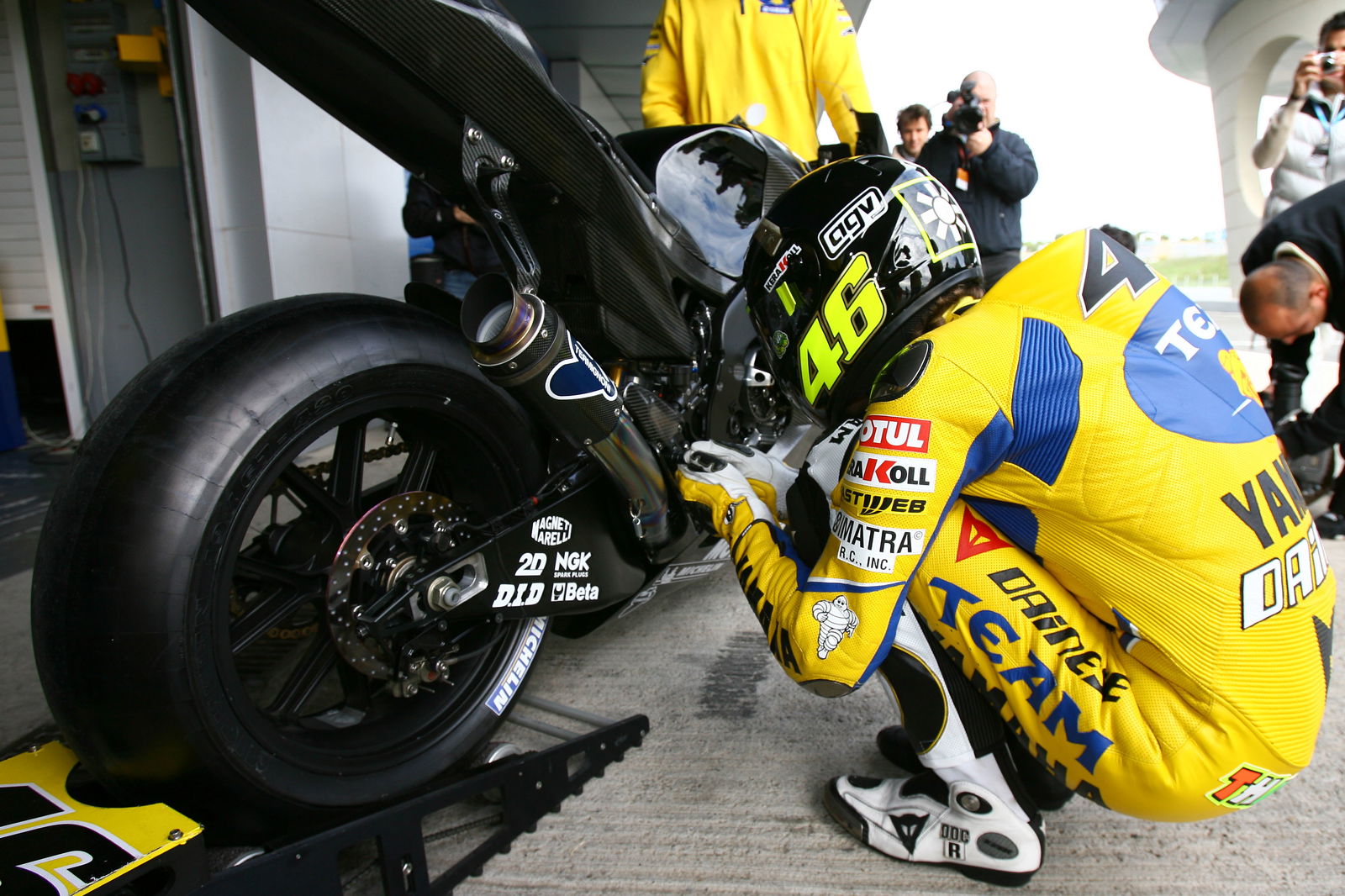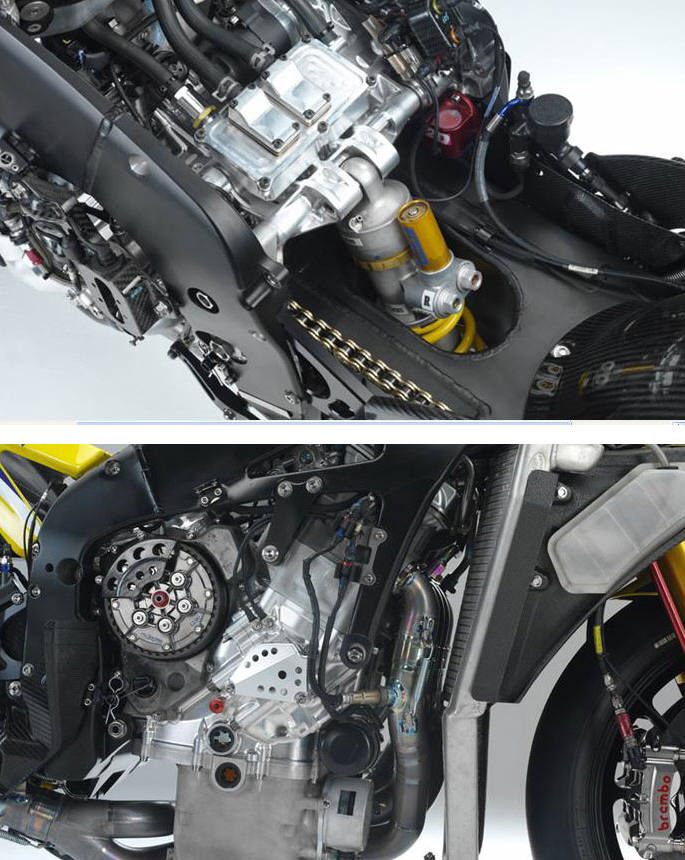Evolution of the YZR-M1 - part one.
The end of the 2006 MotoGP season also marked the last ever race for the 990cc prototypes, including Yamaha's YZR-M1, with new 800cc engine regulations being introduced for next season.
During the five-years that it raced, the M1 claimed 27 MotoGP victories - two with Max Biaggi (2002) and 25 with Valentino Rossi (2004-2006) - plus two riders' world championships, with Rossi in 2004 and 2005. The Rossi/Colin Edwards/M1 partnership also gave Yamaha the 2005 constructors' championship and the teams' title in both 2004 and 2005.

The end of the 2006 MotoGP season also marked the last ever race for the 990cc prototypes, including Yamaha's YZR-M1, with new 800cc engine regulations being introduced for next season.
During the five-years that it raced, the M1 claimed 27 MotoGP victories - two with Max Biaggi (2002) and 25 with Valentino Rossi (2004-2006) - plus two riders' world championships, with Rossi in 2004 and 2005. The Rossi/Colin Edwards/M1 partnership also gave Yamaha the 2005 constructors' championship and the teams' title in both 2004 and 2005.
This year, Rossi came within five-points of his sixth consecutive world championship and, after the season-ending Valencian Grand Prix, YZR-M1 project leader Koichi Tsuji gave a technical presentation detailing the evolution of Yamaha's MotoGP machine during the 990cc period, from 2002 to 2006.
Quotes and diagrams from that presentation are shown here (click on pictures to enlarge), with part one detailing how the M1 has developed since 2002, while part two will concentrate specifically on the 2006 machine, which initially struggled with chatter before a storming fight back put Rossi in the championship lead heading to the Valencia season finale...
"The YZR-M1 has been developed continuously around three main themes; chassis, engine and engine management system," began Tsuji. "For the chassis, we continued Yamaha's tradition of good handling characteristics even further by maximising agility.
"We always want more power from the engine, but at the same time we spent a lot of time trying to achieve a balance between power and drivability, by having a rideable torque character. For the engine control system, so called EMS [engine management system], we always try to create a direct natural feeling.
"This chart [top picture, 'YZR-M1 Concept'] shows the main history of the YZR-M1. In 2002, the bike was based on a 500cc chassis with a four-stroke engine," continued Tsuji. "2003 saw a further evolution, the biggest change being the use of fuel injection instead of carburetor, while the engine brake control system was changed to the ICS [Idle Control System].
"Then in 2004 we enjoyed the arrival of Valentino. Sure his great talent gave Yamaha the world championship, but the engine also saw big changes and progress. We introduced a four valve [instead of five valve] cylinder head and an un-even [big bang] firing order. This made a huge difference in the performance of the YZR-M1.
"For the next two years, we continued to develop the 2004 machine and for the future after 2006 we will continue to develop this very successful concept."
Tsuji then returned to the three main development objectives - chassis, engine and engine management system - describing the particular attributes necessary for success in each area (top picture, 'Development objectives of the YZR-M1').
"Firstly the chassis, the YZR-M1's biggest feature is its short wheel base combined with a long swing arm. This is the essence of the YZR-M1 concept. To enhance this character, we evolved the frame, aerodynamics and centralisation of mass," said the Japanese.
"The engine and the engine management system are difficult to separate. A short wheel base can sometimes be a disadvantage in terms of ridability. For example, it is easy to wheelie on acceleration and can be unstable when braking. The engine must have the highest power possible, but at the same time it needs to stay controllable. From 2005, we also focused our development on fuel economy.
"It is also very important to remember that we spend a lot of time making sure that these [engine management] systems are working correctly," he stressed. "With the important sensors, we are using double, so even if one sensor breaks the system will continue to work by using the other sensor. If both sensors break, the bike will stop gradually, but fortunately we have never experienced this situation."
Looking specifically at the M1 frame (middle picture, 'Evolution of frame'), Tsuji revealed how and why Yamaha had kept vertical stiffness, while reducing lateral stiffness.
"The frame determines the bike's character," he said, "Generally the frame is evaluated by the stiffness. The YZR-M1 frame is designed to keep vertical stiffness and reduce lateral stiffness and torsion.
"This is because the bike's suspension only moves in a vertical direction - up and down - so when the bike is banked over [during cornering], the frame must also act as suspension. That is why we focus very much on this element with many tools and simulations.
"For 2005, we removed the cross member. This reduced lateral and torsion stiffness and gave a lot of improvement for agility and stability. At the same time we designed the air-intake passage through the head pipe, this way the frame helped improve the engine performance. These ideas will continue to have an effect in the future."
In terms of aerodynamics, Tsuji explained the conflicting interests of straight-line performance and cross wind stability (middle picture, 'Evolution of aerodynamics').
"Aerodynamics is one of the important things for the bike, so we spent a lot of time on development," he declared. "To put it simply, to have more speed and acceleration, we need to minimise the front view of CDA. CDA means drag co-efficient multiplied by frontal area.
"But for handling and stability against side winds, the aerodynamics of the side view is very important too. Sometimes it is even more important than the front CDA. The problem is that these two subjects are incompatible.
"The YZR-M1 shape is developed mainly to reduce frontal CDA, but through the years we tried to find the best compromise between front and side view."
The aerodynamic data provided by Yamaha indicted that the 2002 M1 had low frontal drag, but relatively poor cross wind stability as a result. The side yaw was then reduced significantly for 2003 and 2004, at the cost of frontal drag, but for 2005 and 2006 Yamaha was able to keep the lower side yaw, while reducing frontal drag back to near the 2002 level.
Mass centralisation around the M1's centre of gravity, a vital element of optimum machine handling, was achieved by evolution of the fuel tank shape, relocation of electrical hardware and improved engine design (middle picture, 'Mass centralization').
"To achieve the best handling, mass concentration around the bike's centre of gravity is very important. Through the years, we've developed this in three main areas," stated Tsuji.
"Firstly the fuel tank. You can imagine that the fuel tank shape can help mass centralisation, but it can also help to keep minimise the weight balance difference [front to rear] between a full or empty tank .You have to remember that the [space provided by an] in-line engine is a great help in achieving this.
"Second is the location of electrical parts. We used to put these under the front panel. The ECU, logger and related parts are not heavy, but their location was a long way from the bike's centre of gravity. This was a problem. So we moved these electrical parts to the tank rail and achieved a big improvement in mass centralisation.
"Third is the engine, we try to design the engine to be as compact as possible. We always focus on finding the best location of the four axis."
The success of these improvements can be seen in the 'Result of mass centralization' diagram (middle picture) where the reduction in inertia - in terms of roll, pitch and yaw - since 2002 is shown. In real terms these reductions result in more responsive handling.
Tsuji then switched his attention to the engine, beginning with the configuration and then how the engine specification had evolved (lower picture, 'Engine configuration' and 'Evolution of engine specification').
"As previous mentioned, the strongest feature of the YZR-M1 is its short wheel base combined with a long swing arm. The in-line engine configuration suits this concept best," he said. "Also, the distance between the crankshaft and axle drive has been shorted year by year and this has enabled the use of a longer rear arm."
"Looking back to 2002 and 2003, the comments from the 2003 press test on the YZR-M1 said everything. The engine was so aggressive and difficult to control," he admitted. "Everybody that rode the bike said that '2004 will be a very difficult season for Valentino'.
"But at the same time, we had already started to develop the new four valve and un-even firing engine. This engine was tested around 2003 Christmas time and we had a big present from Santa Claus!
"When we started working with Valentino at Sepang in January, he confirmed this was the best direction for the engine. But we struggled to get more power from this engine. However, year by year, we improved the power and revs. The engine was given a shorter stroke to increase the revs even further, and for this we changed the valve train system from chain to gear driven."
The results of these changes can be seen in the 'Evolution of engine performance' diagram (lower picture) which illustrates how maximum engine power ands revs has improved year on year - despite fuel tank capacity reductions.
"This diagram shows how engine performance has improved. From 2002-2004, the power has gone up steadily. After the 22 litre fuel limit regulation was introduced [for 2005] the improvement in power slowed down a little. On the other hand, the gear train system gave the engine more revs. Between 2002 and 2006, the engine power rose by approximately 35 horsepower and revs have increased by approximately 3000 rev/min," he confirmed.
The third and final 'theme' of the M1's development since 2002 has been the evolution of the engine management system (lower picture, 'Evolution of EMS'). This initially began as a way of controlling the effect of engine braking when a rider shut the throttle, but has since grown into a much more complex control system covering torque control, traction control, wheelie control, launch control and more.
"When the [four-stroke] MotoGP class started in 2002, EMS just meant engine brake control. Every team struggled with the engine braking generated by the new four-stroke engines," said Tsuji. "The YZR-M1 had the problem too so we tried several systems and the engine braking problem greatly stimulated the development of EMS.
"Through these developments, the YZR-M1 has changed from an ICS [Idle Control System)] to fly-by-wire system."
Fly-by-wire is a term borrowed from the aviation industry and means a control system which works without having a direct mechanical link; for example there is no cable between the throttle and engine. Instead such systems operate indirectly - the rider input acts as a 'request' which is sent electronically to the management system, this then checks data from other sensors (wheel speeds, gear, lean angle etc) to determine how best to execute that 'request'.
"Now the throttle not only controls the engine power but also the chassis!" revealed Tsuji.


